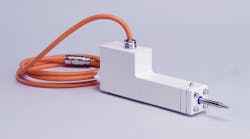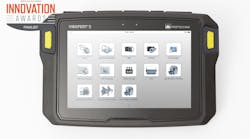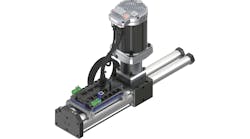Case Study: A Good Night’s Sleep, Thanks to Oil Shear Technology
There are a lot of things that can wake you up at night: a noise in another room, a branch outside tapping the window, a pet leaping onto the bed. A call from the second shift with maintenance troubles shouldn’t be on that list. For years, the cranes at a plant that manufactures telecommunications buildings would fail in the middle of the night, and the unfortunate head electrician was only a phone call away, no matter the hour of night. Thanks to a switch to oil shear crane brakes, however, the cranes and hoists are running (and as importantly, stopping) through the night, allowing that electrician to finally get a good night’s sleep.
The structures that the plant manufactures work their way through an assembly line-like process, with components, utilities and sub-assemblies added along the way. One 7½ ton Yale and six 20-ton Shaw Box cranes service the various areas of the plant floor. Workers often jog the cranes forward and backward to get materials into the precise spot. While that’s convenient for the workers, the constant stopping and starting wreaked havoc with the Stearns and Dings dry brakes that were originally installed on the cranes. The disc stacks would fail, requiring hours of maintenance time. Just when one was fixed, another would go down.
“It was astronomical the amount of downtime and man-hours we were spending,” the electrician remembers.
Seemingly once a week, he would have to shut down the crane, causing a domino effect that stopped production across the facility. The cost of having a production line down for maintenance adds up quickly, and takes exponentially long to recover from.
Once, the second shift maintenance team had been working on the crane for four hours before calling for advice (in the middle of the night). Sure enough, the team hadn’t inspected the brakes, which had failed. It didn’t take long for the plant manager to pressure the team to either find a different brake or a different hoist: anything to save the plant from the amount of downtime they were experiencing.
Just as the plant was desperate for a solution, rescue came in the form of a visit from a regional sales manger of Force Control Industries. Ken Kelly stopped by to talk about Magna Shear Brakes, which employ Oil Shear Technology to ensure a longer service life. The head electrician agreed to put a MagnaShear MB8 brake into service on one of the ShawBox 20-ton cranes as a test. The MagnaShear worked well - and more importantly, required no service for maintenance or adjustment. Within a month, the maintenance team was convinced, and rallied support from the plant manager and executive team to invest in the new brakes.
With several brakes on seven cranes, plus additional hoist brakes, replacing the brakes outright was a significant investment. Still, the cost of the facility going down for crane maintenance was adding up even more, and something had to be done.
“The next thing I knew, we were putting a Force Control Brake on every crane that we operate,” the electrician said.
How Oil Shear Technology Works
Normal dry brakes employ a sacrificial surface – the brake disc or pad – to engage the load. Without a good way to remove the heat caused from engagement between the disk and plate, this sacrificial material must absorb the heat. The extremely high temperatures will eventually degrade the friction material. As the friction surface wears away and begins to glaze the spring force is also reduced causing the ensuing torque fade. This causes positioning errors which typically require adjustment or replacement of the friction surface.
Oil-shear technology plays a major role in ensuring that the cranes in the plant operate continuously. A film of automatic transmission fluid flows between the friction surfaces, and as the brake is engaged, the fluid is compressed. The automatic transmission fluid particles in shear transmit torque to the other side. This torque transmission causes the stationary surface to turn, bringing it up to the same relative speed as the moving surface. Since most of the work is done by the fluid particles in shear, by the time the surfaces actually meet or “lock up” wear is virtually eliminated.
In addition to transmitting torque, the ATF also helps to dissipate heat, due to a patented fluid recirculation system. Along with torque transmission and heat removal, the fluid also serves to continually lubricate all components – thus extending their service life. Oil Shear Technology also provides a “cushioned” stop that reduces shock to the drive system – further extending service life. Unlike dry clutch brakes, the totally enclosed oil shear system is impervious to external elements such as wet, dusty or dirty environments. Since the layer of oil eliminates wear, the MagnaShear motor brake provides a long service life – the original MSB8 installed is still operating, almost ten years later.
Giving the Maintenance Team a Break
With the smaller MSB2 model brakes, it wasn’t as simple. (HOW WERE FAILURES MANIFESTING THEMSELVES?) The shafts on the Baldor ¾ HP motor were not long enough, leading to premature failures. When he heard about the trouble, Ken Kelly worked with his team at Force Control Industries to design a different way to mount the brake, which alleviated the problem.
The less maintenance the cranes need, the better. Not only because of the potential for downtime across the plant, but also the safety hazard posed by working at height.
The cranes are installed at height, close to the 20-ft high ceiling of the facility. Temperatures outside the plant regularly stay above 90? for days on end, cooking the facility from above and creating ambient heat that rises to the top, where the dry brakes were installed. Ambient heat is problematic for dry brakes, which are cooled by the air around the brake. Heightened summer temperatures shortened the pads service life, and lead to disks glazing over, which are some of the problems that led to the brakes needing so much attention.
The Oil Shear technology dissipates heat through the oil that recirculates through the brake, keeping the system consistently cool, despite the temperature outside.
Other than changing the oil annually, the Magna Shear brakes have operated flawlessly. They get inspected once a month, along with the regular inspection of the rest of the crane—a regularly scheduled, routine maintenance check.
Through their longevity alone, the brakes have made up for their initial cost by preventing costly production downtime. After the switch to oil shear brakes, the maintenance team doesn’t have to harness up to repair a worn out dry brake, or keep a shelf full of spare parts (discs, springs, etc) for the old dry brakes. Most importantly, with no surprise wake up calls from the second shift crew, the head electrician at the plant gets to sleep through the night.







